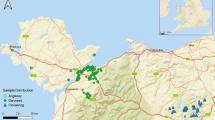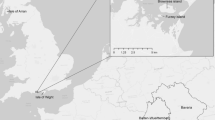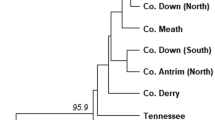Abstract
The Eurasian red squirrel’s (Sciurus vulgaris) history in Ireland is largely unknown, but the original population is thought to have been driven to extinction by humans in the seventeenth century, and multiple records exist for its subsequent reintroduction in the nineteenth century. However, it is currently unknown how these reintroductions affect the red squirrel population today, or may do so in the future. In this study, we report on the development of a DNA toolkit for the non-invasive genetic study of the red squirrel. Non-invasively collected red squirrel samples were combined with other samples collected throughout Ireland and previously published mitochondrial DNA (mtDNA) data from Ireland, Great Britain and Continental Europe to give an insight into population genetics and historical introductions of the red squirrel in Ireland. Our findings demonstrate that the Irish red squirrel population is on a national scale quite genetically diverse, but at a local level contains relatively low levels of genetic diversity, and there is also evidence of genetic structure. This is likely an artefact of the introduction of a small number of genetically similar animals to specific sites. A lack of continuous woodland cover in Ireland has prevented further mixing with animals of different origins that may have been introduced even to neighbouring sites. Consequently, some of these genetically isolated populations are or may in the future be at risk of extinction. The Irish red squirrel population contains mtDNA haplotypes of both a British and Continental European origin, the former of which are now extinct or simply not recorded in contemporary Great Britain. The Irish population is therefore important in terms of red squirrel conservation not only in Ireland, but also for Great Britain, and should be appropriately managed.





Similar content being viewed by others
References
Bandelt HJ, Forster P, Röhl A (1999) Median-joining networks for inferring intraspecific phylogenies. Mol Biol Evol 16:37–48
Barratt EM, Gurnell J, Malarky G, Deville R, Bruford MW (1999) Genetic structure of fragmented populations of red squirrel (Sciurus vulgaris) in the UK. Mol Ecol 8:55–63
Barrington RM (1880) On the introduction of the squirrel into Ireland. Scientific proceedings of the Royal Dublin. Society 2:615–631
Broquet T, Ménard N, Petit E (2007) Noninvasive population genetics: a review of sample source, diet, fragment length and microsatellite motif effects on amplification success and genotyping error rates. Conserv Genet 8:249–260
Brownstein MJ, Carpten JD, Smith JR (1996) Modulation of nontemplated nucleotide addition by tag DNA polymerase: primer modifications that facilitate genotyping. BioTechniques 20:1004–1010
Chantrey J, Dale TD, Read JM, White S, Whitfield F, Jones D, McInnes CJ, Begon M (2014) European red squirrel population dynamics driven by squirrelpox at a gray squirrel invasion interface. Ecol Evol 4(19):3788–3799. https://doi.org/10.1002/ece3.1216
Earl DA, vonHoldt BM (2012) Structure Harvester: a website and program for visualizing structure output and implementing the Evanno method. Conserv Genet Resour 4(2):359–361. https://doi.org/10.1007/s12686-011-9548-7
Evanno G, Regnaut S, Goudet J (2005) Detecting the number of clusters of individuals using the software structure: a simulation study. Mol Ecol 14(8):2611–2620
Excoffier L, Lischer HL (2010) Arlequin version 3.5: a new series of programs to perform population genetic analyses under Linux and Windows. Mol Ecol Resour 10(3):564–567. https://doi.org/10.1111/j.1755-0998.2010.02847.x
Fairley JS (1983) Exports of wild mammal skins from Ireland in the eighteenth century. Irish Nat J 21:75–79
Falush D, Stephens M, Pritchard JK (2003) Inference of population structure using multilocus genotype data: linked loci and correlated allele frequencies. Genetics 164:1567–1587
Finnegan LA, Edwards CJ, Rochford JM (2008) Origin of, and conservation units in, the Irish red squirrel (Sciurus vulgaris) population. Conserv Genet 9(5):1099–1109. https://doi.org/10.1007/s10592-007-9419-7
Finnegan LA, Poole A, Lawton C, Rochford JM (2009) Morphological diversity of the red squirrel, Sciurus vulgaris, in Ireland. Eur J Wildl Res 55(2):145–151. https://doi.org/10.1007/s10344-008-0228-1
Frantz AC, Cellina S, Krier A, Schley L, Burke T (2009) Using spatial Bayesian methods to determine the genetic structure of a continuously distributed population: clusters or isolation by distance? J Appl Ecol 46:493–505
Grill A, Amori G, Aloise G, Lisi I, Tosi G, Wauters LA, Randi E (2009) Molecular phylogeography of European Sciurus vulgaris: refuge within refugia? Mol Ecol 18(12):2687–2699. https://doi.org/10.1111/j.1365-294X.2009.04215.x
Hale ML, Bevan R, Wolff K (2001b) New polymorphic microsatellite markers for the red squirrel (Sciurus vulgaris) and their applicability to the grey squirrel (S. carolinensis). Mol Ecol Notes 1:47–49
Hale ML, Lurz PWW, Wolff K (2004) Patterns of genetic diversity in the red squirrel (Sciurus vulgaris L.): footprints of biogeographic history and artificial introductions. Conserv Genet 5(2):167–179. https://doi.org/10.1023/B:COGE.0000030001.86288.12
Hickie D (2004) Irish hedgerows: networks for nature. Networks for Nature, Dublin
IUCN/SSC (2013). Guidelines for Reintroductions and Other Conservation Translocations. Version 1.0. Gland, Switzerland: IUCN Species Survival Commission, viiii + 57 pp
Kopelman NM, Mayzel J, Jakobsson M, Rosenberg NA, Mayrose I (2015) Clumpak: a program for identifying clustering modes and packaging population structure inferences across K. Mol Ecol Resour 15(5):1179–1191. https://doi.org/10.1111/1755-0998.12387
Lawton C, Flaherty M, Goldstein EA, Sheehy E, Carey M (2015) Irish squirrel survey 2012. Irish wildlife manuals, no. 89. National Parks and wildlife service, Department of Arts, heritage and the Gaeltacht, Ireland
Le Fanu TV (1922) The squirrel in Ireland. The. Irish Nat J 31:83–84
Librado P, Rozas J (2009) DnaSP v5: a software for comprehensive analysis of DNA polymorphism data. Bioinformatics 25:451–1452
Martínková N, McDonald RA, Searle JB (2007) Stoats (Mustela erminea) provide evidence of natural overland colonisation of Ireland. Proc R Soc Lond Ser B 274(1616):1387–1393. https://doi.org/10.1098/rspb.2007.0334
McDevitt AD, Vega R, Rambau RV, Yannic G, Herman JS, Hayden TJ, Searle JB (2011) Colonization of Ireland: revisiting ‘the pygmy shrew syndrome’ using mitochondrial, Y chromosomal and microsatellite markers. Heredity 107(6):548–557. https://doi.org/10.1038/hdy.2011.41
Miller GS (1912) Catalogue of the mammals of western Europe. British Museum, London
Mondol S, Bruford MW, Ramakrishnan (2013) Demographic loss, genetic structure and the conservation implications for Indian tigers. Proc R Soc B 280(1762):20130496. https://doi.org/10.1098/rspb.2013.0496
Montgomery WI, Provan J, McCabe AM, Yalden DW (2014) Origin of British and Irish mammals: disparate post-glacial colonisation and species introductions. Quat Sci Rev 98:144–165. https://doi.org/10.1016/j.quascirev.2014.05.026
Mullins J, Statham MJ, Roche T, Turner PD, O’Reilly C (2010) Remotely plucked hair genotyping: a reliable and noninvasive method for censusing pine marten (Martes martes, L. 1758) populations. Eur J Wildl Res 56(3):443–453. https://doi.org/10.1007/s10344-009-0332-x
Nei M (1972) Genetic distance between populations. Am Nat 106:283–292
Nei M (1978) Estimation of average heterozygosity and genetic distance from a small number of individuals. Genetics 89:583–590
O’Mahony DT, Powell C, Power J, Hanniffy R, Marnell F, Turner P, O’Reilly C (2017) Non-invasively determined multi-site variation in pine marten Martes martes density, a recovering carnivore in Europe. Eur J Wildl Res 63(3):48. https://doi.org/10.1007/s10344-017-1108-3
O’Meara DB, Turner PD, Coffey L, O’Reilly C (2012) TaqMan® assays for species identification of the red squirrel (Sciurus vulgaris) and the grey squirrel (Sciurus carolinensis). Conserv Genet Resour 4(3):603–604. https://doi.org/10.1007/s12686-012-9602-0
O’Neill D, Turner PD, O’Meara DB, Chadwick EA, Coffey L, O’Reilly C (2013) Development of novel real-time TaqMan® PCR assays for the species and sex identification of otter (Lutra lutra) and their application to noninvasive genetic monitoring. Mol Ecol Resour 13(5):877–883. https://doi.org/10.1111/1755-0998.12141
Ogden R, Shuttleworth C, McEwing R, Cesarini S (2005) Genetic management of the red squirrel, Sciurus vulgaris: a practical approach to regional conservation. Conserv Genet 6:511–525
Peakall R, Smouse PE (2006) GENALEX 6: genetic analysis in excel. Population genetic software for teaching and research. Mol Ecol Notes 6(1):288–295. https://doi.org/10.1111/j.1471-8286.2005.01155.x
Pritchard JK, Stephens P, Donnelly P (2000) Inference of population structure using multilocus genotype data. Genetics 155:945–959
Reiners TE, Encarnação JA, Wolters V (2011) An optimized hair trap for noninvasive genetic studies of small cryptic mammals. Eur J Wildl Res 57(4):991–995. https://doi.org/10.1007/s10344-011-0543-9
Sheehy E, Lawton C (2014) Population crash in an invasive species following the recovery of a native predator: the case of the American grey squirrel and the European pine marten in Ireland. Biodivers Conserv 23(3):753–774. https://doi.org/10.1007/s10531-014-0632-7
Sheehy E, O’Meara DB, O’Reilly C, Smart A, Lawton C (2014) A noninvasive approach to determining pine marten abundance and predation. Eur J Wildl Res 60(2):223–226. https://doi.org/10.1007/s10344-013-0771-2
Shibata K, Bandoh K, Yaekashiwa N, Matsuzaki T, Tamate HB (2003) A simple method for isolation of microsatellites from the Japanese squirrel (Sciurus lis) without constructing a genomic library. Mol Ecol Notes 3:657–658
Shorten M (1954) Squirrels. Collins, St. James’s Place London
Signorile AL, Lurz PWW, Wang J, Reuman DC, Carbone C (2016) Mixture or mosaic? Genetic patterns in UK grey squirrels support a human-mediated ‘long-jump’ invasion mechanism. Divers Distrib 22(5):566–577. https://doi.org/10.1111/ddi.12424
Simpson S, Blackett T, Blampied N, Peniche G, Dozierez A, Cornish N, Groombridge JJ (2013) Genetic structure of introduced populations : 120-year-old DNA footprint of historic introduction in an insular small mammal population. Ecol Evol 3(3):614–628. https://doi.org/10.1002/ece3.486
Tamura K, Peterson D, Peterson N, Stecher G, Nei M, Kumar S (2011) MEGA5: molecular evolutionary genetics analysis using maximum likelihood, evolutionary distance, and maximum parsimony methods. Mol Biol Evol 28:2731–2739
Teagasc (2016) Ireland’s forests—annual statistics 2016. Department of Agriculture, Food and Marine, Dublin
Thorington RT, Koprowski JL, Steele MA, Whatton JF (2012) Squirrels of the world. John Hopkins University Press, Baltimore
Todd R (2000) Microsatellite loci in the Eurasian red squirrel, Sciurus vulgaris. Mol Ecol 9(12):2165–2166. https://doi.org/10.1046/j.1365-294X.2000.10536.x
Trizio I, Crestanello B, Galbusera P, Wauters LA, Tosi G, Matthysen E, Hauffe HC (2005) Geographical distance and physical barriers shape the genetic structure of Eurasian red squirrels (Sciurus vulgaris) in the Italian Alps. Mol Ecol 14(2):469–481. https://doi.org/10.1111/j.1365-294X.2005.02428.x
Valière N (2002) GIMLET: a computer program for analysing genetic individual identification data. Mol Ecol Notes 2:377–379
van Oosterhout C, Hutchinson W, Willds D, Shipley P (2004) MICROCHECKER: software for identifying and correcting genotyping errors in microsatellite data. Mol Ecol Notes 4(3):535–538. https://doi.org/10.1111/j.1471-8286.2004.00684.x
Weckworth BV, Musiani M, AD MD, Hebblewhite M, Mariani S (2012) Reconstruction of caribou evolutionary history in Western North America and its implications for conservation. Mol Ecol 21(14):3610–3624. https://doi.org/10.1111/j.1365-294X.2012.05621.x
Acknowledgements
We would like to thank Síle and Seán Murphy for access to their woodland at Mahon Bridge, Co. Waterford and Andrew Doherty for his help locating suitable survey sites near Faithlegg, Co. Waterford. Our reviewers kindly provided very helpful reviews, and their suggestions helped us to improve the discussion and overall clarity of the manuscript.
Author information
Authors and Affiliations
Corresponding author
Additional information
Communicated by: Jan M. Wójcik
Electronic supplementary material
ESM 1
(DOCX 68 kb)
Rights and permissions
About this article
Cite this article
O’Meara, D.B., McDevitt, A.D., O’Neill, D. et al. Retracing the history and planning the future of the red squirrel (Sciurus vulgaris) in Ireland using non-invasive genetics. Mamm Res 63, 173–184 (2018). https://doi.org/10.1007/s13364-018-0353-5
Received:
Accepted:
Published:
Issue Date:
DOI: https://doi.org/10.1007/s13364-018-0353-5




